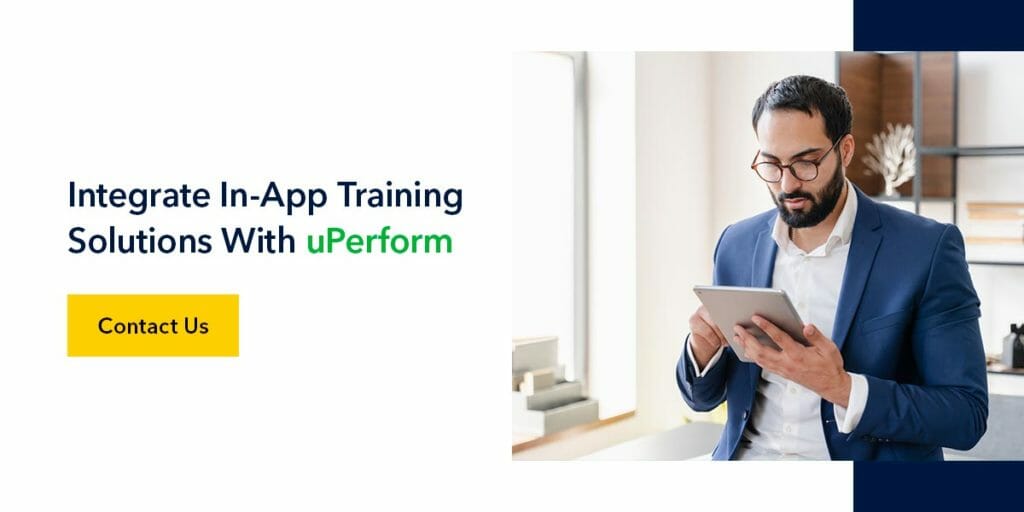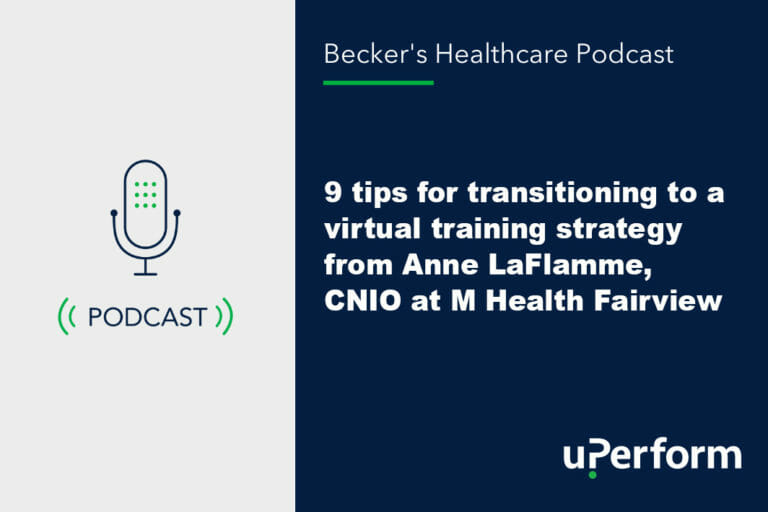Asynchronous learning has quickly become a mainstay in L&D organizations across industries. The ability to allow people to learn when and how they prefer not only became a necessity during the COVID-19 Pandemic, but it is proving to be a superior method for learning in the workplace. uPerform‘s just-in-time learning platform powers in-app learning, enabling employees to develop skills and understand software features directly in the flow of work. uPerform® is not only a platform for delivering these in-app learnings, it also helps your education team create engaging microlearnings, interactive in-app training modules that benefit all your software users.
What is in-app learning?
In-app learning takes place within the software that runs your business. Many applications have comprehensive onboarding materials and demonstrations to help users get acquainted with their features and tools. In-app learning takes that to the next level by allowing users to revisit materials at their own pace and discover more advanced features to enhance their efficiency after formal onboarding has been completed. As with the traditional asynchronous learning, digital in-app learning content is easy to consume and can offer a variety of formats like interactive walkthroughs or captivating videos to cater to individual learning preferences.
For example, during initial training, healthcare employees might learn to use the Electronic Health Record (EHR) system to review patient charts and update treatment and medical information. However, the EHR also offers advanced analytics to improve care based on their history and data that are often not able to be taught in a traditional classroom model. A nurse might need to use this feature when unsure which treatment option is most compatible with their patient’s current treatment. In-app learning empowers these users to go deeper to understand more complex features, utilizing interactive, role-specific instructions helping them master a new skill in the flow of work.
The benefits of learning in the flow of work
Compared to in-person training or longer onboarding modules, in-app learning offers several benefits to your healthcare employees, including:
- Reducing onboarding costs: Traditional in-person onboarding is time-consuming and cost prohibitive. Many organizations lack adequate classroom space or the resources to hire enough full-time trainers. When employees work remotely or at different locations, travel requirements associated with in-person training can put additional pressure on time and budget constraints. Offering in-app, self-paced learning opportunities can be an affordable solution for your organization’s learning needs by allowing new hires to learn remotely and trainers to focus more time on what drives the most value.
- Accelerating the onboarding process: Traditional onboarding programs often require days of in-person training before hires can begin their new roles. In-app training offers more flexibility, even allowing new hires to begin their training before arriving onsite. Since implementing just-in-time training in the workflow, UCHealth can onboard new clinicians and get them on the floor visiting with patients in as little as two to three hours.
- Simplifying the onboarding process: Onboarding can be overwhelming when employees receive too much information at once. Further, they will likely forget important processes and workflows before they have a chance to put them into practice. In-app help lets them learn at their own pace and revisit materials as needed.
- Boosting learning engagement: A positive training experience supplemented with ongoing support increases user confidence and engagement with software tools. Additionally, your employees might be more accepting of new or changing technology, knowing they are supported through the adjustment with the latest learning innovations. When M Health Fairview embedded learning materials in the flow of work for a new eConsent tool, engagement with the new tool increased from just 7% to 87%.
- Increasing user proficiency: Ongoing training is a key component to software satisfaction and proficiency. By offering access to learning materials in the flow of work, organizations can support employees on their self-paced learning journeys, allowing them to be more proficient and satisfied software users.
With in-app learning, onboarding can be a more productive and satisfying experience for new hires, while saving organizations time and money. Existing employees continue to benefit from learning opportunities that occur within their flow of work, so they never have to walk away from what’s most important.
What makes learning in-app more effective?
In-app learning is particularly effective for your employees, helping establish long-lasting technical skills they use daily. This training method has unique qualities that make it more effective than other, more formal types of learning:
- Interactive: In-app learning provides a variety of content format options, many of which offer a more interactive learning experience. For example, walkthroughs and tutorials prompt users to follow along, pressing buttons and carrying out tasks. This learning method helps solidify training, test users’ skills, and reduces the risk of them forgetting what they heard in an 8-hour in-person training course.
- Contextual: This training type allows your employees to learn in the moment, with learning content tailored to their role and specialty, making skills and processes more relevant. In-app learning creates opportunities to teach skills when needed, keeping employees invested in education and better preparing them to use their new skills again. Contextual learning also allows employees to immediately put what they’ve learned into practice, improving retention.
- Accessible: In-app learning opportunities are always available, which means your employees can learn at any time while they use the software. Help content is easy to find and can be delivered in multiple formats, allowing employees to access learning content that matches their preferred learning style.
- Scalability and consistency: In-app learning offers a more scalable and consistent solution for training teams to onboard employees and communicate change. With traditional training methods, learner experience can vary based on the instructor or other external factors. Furthermore, available learning modules may be limited based on organizational capacity. In-app learning materials delivered by a central training team establish a consistent learning experience that can be repeated for various topics and distributed to all relevant personnel.
How to deliver in-app training
When planning to use in-app learning in your organization, you must know how to integrate it. The pre- and post-integration steps are crucial to learning success, helping you make more informed decisions.
1. Develop a learning strategy
You need a training strategy to direct your efforts when creating in-app learning modules. Your strategy will answer the following questions:
- Who is this training for?
- What is its purpose?
- What medium(s) will you use?
- What content will it contain?
- Why is this training needed? Why is it important?
These questions will help you organize and distribute your training effectively, so your employees have rapid, moment-of-need access to help. Each learning opportunity will have a unique strategy, helping build employees’ proficiency with the mission-critical software they interact with daily.
2. Create and launch your training
After you have your strategies outlined, it’s time to start working on content creation and curation. When considering in-app learning software solutions, think about your content creation and curation tools. Do they support multiple file formats? Will they allow you to continue using the content you’ve already created? Content creation can be a time-consuming process, so it’s important to find a software solution that accelerates content creation and allows you to reuse existing content.
3. Analyze results
After launching your in-app learning, you need a way to measure its success. Performance analytics can help you better understand your employees’ learning preferences and identify areas where they struggle with the software, so you can create learning content that supports their unique needs and builds proficiency. You can analyze program success through several metrics:
- Starting and completion rates: Your in-app learning insights can help you understand its success. Reporting can tell you how many users started and finished the training. Comparing the two can help you create more interactive and engaging content that motivates users to complete every module.
- Feature usage: After launching your in-app training, you can determine how helpful it was by how many people use your feature. If usage rises and remains consistent, you can judge that your employees learned what they needed to implement that feature into their daily tasks from your training.
- Ratings and Feedback: When your employees access in-app performance support or training, your organization can prompt them to fill out a short survey rating their experience. This input can help you understand their feelings about their experience, which is hard to capture in other metrics.
- Performance Metrics: Analyzing job performance metrics of those who access help can determine if your learning content is having a positive effect on organizational efficiency and key performance indicators for your business.
Deliver in-app training with uPerform
You need the right software solution when you want to launch quality and helpful in-app training modules. uPerform is a just-in-time learning and support platform that helps you create and implement training content for your employees. uPerform integrates with your enterprise software, including Epic®, Oracle Cerner®, SAP®, Oracle®, and Workday®, helping your employees become more proficient and satisfied users. Allowing your organization to amplify the benefits of your key software solutions. When planning software updates, uPerform enables you to rapidly prepare learning content for increased employee support. Discover how in-app training with uPerform works for your application.





